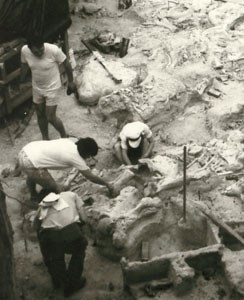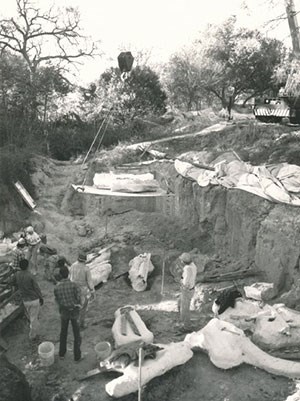
Dominick J. Cirincione
Waco Mammoth National Monument sits within 100 acres of wooded parkland along the Bosque River. Surrounded by oak, mesquite and cedar trees, the site offers an escape from the modern world and provides a glimpse into the lives and habitat of Columbian mammoths and other Ice Age animals.
On a spring day in 1978, Paul Barron and Eddie Bufkin embarked on a search for arrowheads and fossils near the Bosque River. To their surprise, the men stumbled upon a large bone eroding out of a ravine. Recognizing the unusual nature of the find, they removed the bone and took it to Baylor University's Strecker Museum (predecessor to the Mayborn Museum Complex) for examination. Museum staff identified the find as a femur bone from a Columbian mammoth (Mammuthus columbi). This now extinct species lived during the Pleistocene Epoch (more commonly known as the Ice Age) and inhabited North America from southern Canada to as far south as Costa Rica.

Dominick J. Cirincione Strecker Museum staff quickly organized a team of volunteers and excavation began at the site. Using hand tools such as brushes and bamboo scrapers, crews slowly excavated a lost world. Between 1978 and 1990, the fossil remains of 16 Columbian mammoths were discovered. Their efforts uncovered a nursery herd that appears to have died together in a single natural event. Between 1990 and 1997, six additional mammoths were excavated, including a large male (bull). Crews also uncovered the remains of a Western camel (Camelops hesternus), dwarf antelope, American alligator, giant tortoise, and the tooth of a juvenile saber-toothed cat (Smilodon sp.), which was found next to an unidentified animal. Since the discovery of the site in 1978, museum staff, students and volunteers have spent thousands of hours excavating and working to preserve the fossil material. While the remains excavated through 1990 are now housed at Baylor University's Mayborn Museum Complex, most of the fossil specimens excavated since then remain in situ (still in their original position within the bone bed). These specimens have been protected in recent years by a climate-controlled Dig Shelter, allowing for both public viewing and further scientific study.
Dominick J. Cirincione Scientists from Baylor University and many other institutions have conducted research on such topics as the age of the fossils, what plants the animals ate, and the circumstances under which they were trapped and buried. How the mammoths died is still a mystery. No evidence of human involvement has been found, and many of the remains were not disturbed by scavengers. One of the first hypotheses was that the animals all perished in a flash flood. However, recent research has indicated that between 65,000 and 72,000 years ago, a nursery herd of at least 19 mammoths were trapped and drowned by rapidly rising flood waters from the Bosque River. A camel also appears to have been trapped by this flood. Subsequent floods buried the remains. Some years later, an unidentified animal associated with a juvenile saber-toothed cat died and was buried. And, finally, another flood event occurred which trapped and killed the bull, juvenile and female mammoths.
In 2015, President Barack Obama signed an executive order establishing Waco Mammoth National Monument and making this site a new unit of the National Park System.
|
Last updated: July 9, 2015
